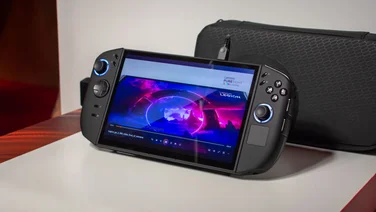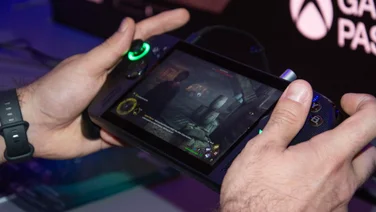To help us provide you with free impartial advice, we may earn a commission if you buy through links on our site. Learn more








- Decent mic quality
- Lightweight and comfortable
- Spatial audio is a delight
- Limited features on PS5
- Bass lacking in weight
The Sony Inzone H5 lagged behind the rest of its party but has finally joined the chat and is ready to step in as an enticing middle ground between last year’s Inzone H3 and Inzone H7.
Like its stablemates that launched last year, the Inzone H5 may look as though it was spawned by the PlayStation 5, but those deceiving looks shroud a headset that is primarily designed for PC gaming and includes console compatibility almost as an afterthought.
READ NEXT: Best gaming headset
That’s not necessarily a bad thing, as some of the features that are omitted from PS5, like Sony’s 360 Reality Audio, would be redundant inclusions given the PS5 offers its own 3D Tempest audio. I did miss the extra level of audio customisation available on PC when playing on PS5, but otherwise, there’s little to dislike here. If you’re looking for an affordable headset for multi-platform gaming, the Sony Inzone H5 should be high on your list.
Retailing for £129, the Inzone H5 lands in direct competition with some of our favourite mid-range headsets, including the Corsair HS80 RGB (£135), and the Logitech G733 Lightspeed (currently just £109).
Like the pricier Inzone H7 (£177) and Inzone H9 (£179), the H5 takes design cues from the PS5, with the model I received for review coming in a stylish black and white colourway. You can also pick up the headset in all black, but for my money, the splash of white helps keep the all-plastic build from looking too cheap.Any reservations about the excess of plastic are quickly forgiven, however, when you slip the H5 over your ears – this thing is seriously light. At just 260g, it’s a fair bit lighter than the H7 (325g) and the Corsair HS80 RGB (367g), and even sneaks under the Logitech G733 Lightspeed (273g). Adding to the comfort are the soft nylon ear cushions, which may not be as plush as memory foam, but are more breathable. Granted, it’s the middle of winter, but even after a few hours of gaming, they never warmed up to the point of discomfort.
The right ear cup is relatively sparse, with only the power button up front and a pair of buttons for adjusting your game/party chat mix further around the back. The left cup is home to the attached mic – instead of a mute button, you simply flip the mic down to talk and back up to cut your feed – as well as a volume dial, and the USB-C and 3.5mm ports.








On the connectivity front, you’ve got the choice of a wired connection via the provided 3.5mm cable, or going wireless with the included 2.4GHz dongle. The latter has a handy toggle on it that designates whether you’re playing on PC or PS5. Unlike the Inzone H7 and H9, there’s no option for simultaneous Bluetooth connection here, so you can’t keep your phone hooked up to the headset while gaming. That’s far from a common feature in this price range, though, so its absence isn’t a mark against the H5.
While PS5 gamers are locked into the in-console settings, players on Windows PCs get an extra level of customisation via the Inzone Hub. Here, you can toggle between the Flat, Bass Boost and Music/Video EQs, or use the ten-band graphic equaliser to create your own tuning, set the dynamic range control between high, low and off, and enable 360 Reality Audio.
Doing the latter will naturally place extra strain on the battery life, but this never proved to be too much of a problem. Sony quotes the H5 as lasting for up to 28 hours on a single charge, and my time with it gave me no reason to doubt that figure. Even after several multi-hour gaming sessions, I tapped the power button and the voice in my ear informed me I was still at “about 50%”. When the power does finally give out, a ten-minute charge should provide enough juice for a further three hours of use.
READ NEXT: Best gaming laptop
Sony Inzone H5 review: What does it do well?
Like the rest of the Inzone over-ear headsets, the H5 is fitted with a pair of 40mm drivers, and even before I fiddled with the settings, audio quality was impressive. When booting up Baldur’s Gate 3 on PS5, I took a moment to linger on the dashboard and enjoy the twinkling, ethereal notes of Down By The River. Though this version doesn’t include the main vocals, it’s still a layered track, and I was impressed with how well the H5 organised the densely populated mid-section, leaving plenty of room for the trebles to shine.
Getting into the game proper, I set up the Tempest 3D audio and had a wander around the titular city, enjoying the accuracy with which ambient dialogue was positioned around my head. Things got even better when I went out and picked a fight: hearing the blast of my wizard’s spell travel from off to my right to slam into a goblin down on my left felt wonderfully immersive, and the crackling sound of it burning to a crisp was the icing on the cake.








While turn-based games don’t give as much opportunity for quick reactions, the 3D audio stepped up in Spider-Man 2. Swinging low over the city and hearing the rush of traffic beneath my feet was an enjoyable novelty, but it wasn’t until I was fending off a pack of late-game enemies that I truly appreciated the tactical aspect. A quick snarl was enough to tell me that trouble was headed my way, and from what direction. I won’t go so far as to call it a Spidey Sense, but dodging an enemy that you heard from offscreen is particularly satisfying.
Using the 360 Reality Audio on PC is as easy as flicking a switch in the Inzone Hub, although personal optimisation requires you to download a separate app and take pictures of your ears. That’s a bit of a pain, but once it’s out of the way, the spatial audio is a blast. Chaotic firefights in Starfield proved an excellent showcase for its uses, and I quickly found myself tracking enemies’ positions by the sound of their gunfire instead of squinting at the compass. Accuracy is decent enough to give a good idea of distance and vertical positioning, which is invaluable when you’re flailing around in zero gravity trying to figure out which way is up.








We’ve previously had issues with the mic quality on the Inzone series, but the introduction of AI-based noise reduction to the bidirectional boom mic is a bit of a game changer. I tested it out with a fan, a video of blustery wind and the kind of frantic keyboard mashing that comes from a tense boss fight, and in every instance, I was told that my voice came through clearly. Better still, I had to get the mic very close to the noise source before any of it became audible to my gaming buddies, which is a big improvement over the H7 and H9.
Sony Inzone H5 review: What could be improved?
Now, while I’m gaming, I don’t want bass so heavy that it rattles my skull every five seconds, but when I’m laying down a particularly meaty spell in Baldur’s Gate 3 or chaining shotgun kills in Doom Eternal, I want to be able to feel it. With the Inzone H5, the lower end feels a little dampened, especially when laid alongside such well-articulated mid-frequencies. Switching over to the Bass Boost EQ went some way to patching the problem, but the results were still a tickle when I was looking for a punch.








Even if I’d been able to settle on a perfect tuning, it would have done little good when switching over to something like Spider-Man 2, as changes made in the Inzone Hub don’t transfer to PS5. This isn’t a huge problem, as the Tempest 3D audio works well enough and the PS5 has settings for adjusting mic volume and sidetone, but it’s still frustrating that you can’t carry over your personalised tuning when swapping platforms. With the option right there on the PC, it can’t help but make the PS5 support feel undercooked by comparison.
Another issue that cropped up on PS5 is that the controller’s mute button is disabled while the headset is connected. That’s not too egregious – the flip-up mic does its job well enough – but there’s a mute button on the controller for a reason. If you’re in the middle of a tense firefight and want a bit of privacy while you suffer a hacking coughing fit, for instance, you’ll have to take a hand off the control to quickly flip your mic up. Like I say, not the biggest of deals, but it feels unnecessarily restrictive.
READ NEXT: Best gaming headset for PS5 and Xbox Series X|S
Sony Inzone H5 review: Should you buy it?
Otherwise, the Inzone H5 doesn’t do all that much wrong. By far the most frustrating thing about the Inzone series is Sony’s refusal to synergise and optimise the headsets for PS5 as much as PC. With some of the key features essentially locked off, I can’t recommend this headset for those playing solely on PS5 – you’re better off saving money and picking up a Pulse 3D headset or spending the same amount on the new Pulse Elite.
If, however, you dabble in multi-platform gaming, there’s a strong argument to be made for the Inzone H5. Its lightweight frame and nylon ear cushions make it one of the most comfortable gaming headsets I’ve used, the 360 Reality Audio is a lot of fun and the new AI noise-reduction sees a big improvement in the mic department. As long as you’re not fussed about Bluetooth connectivity, the Sony Inzone H5 is a terrific alternative for those who don’t want to fork out for the likes of the Inzone H7 and H9.







